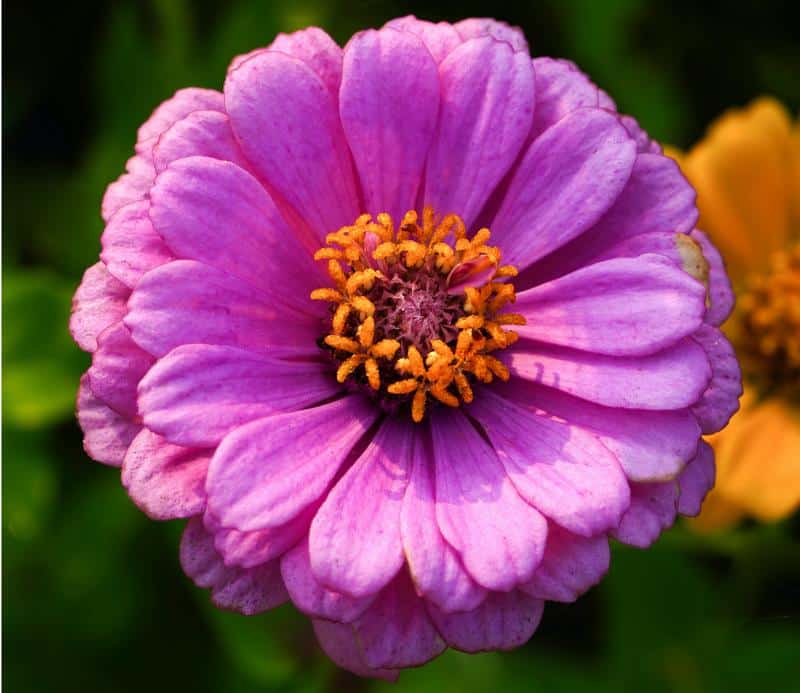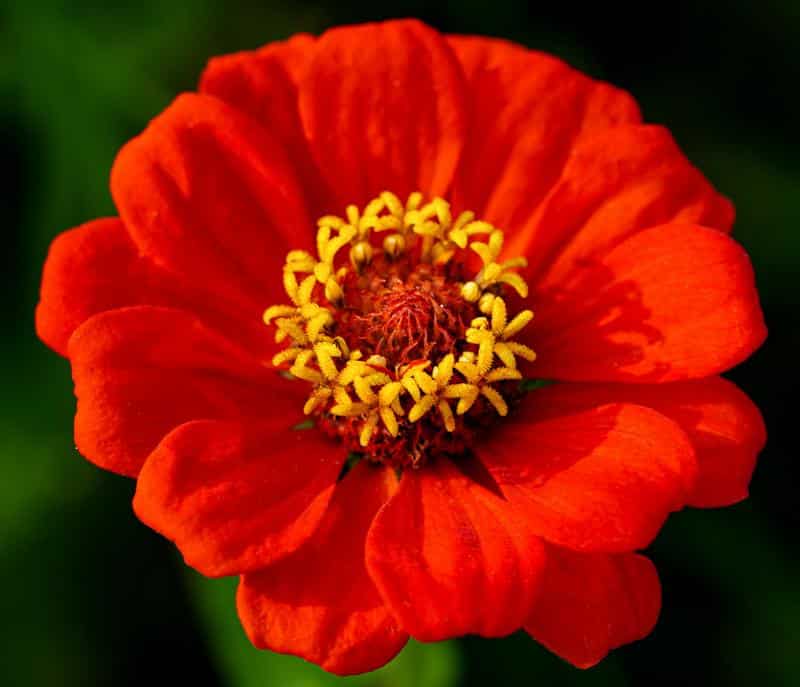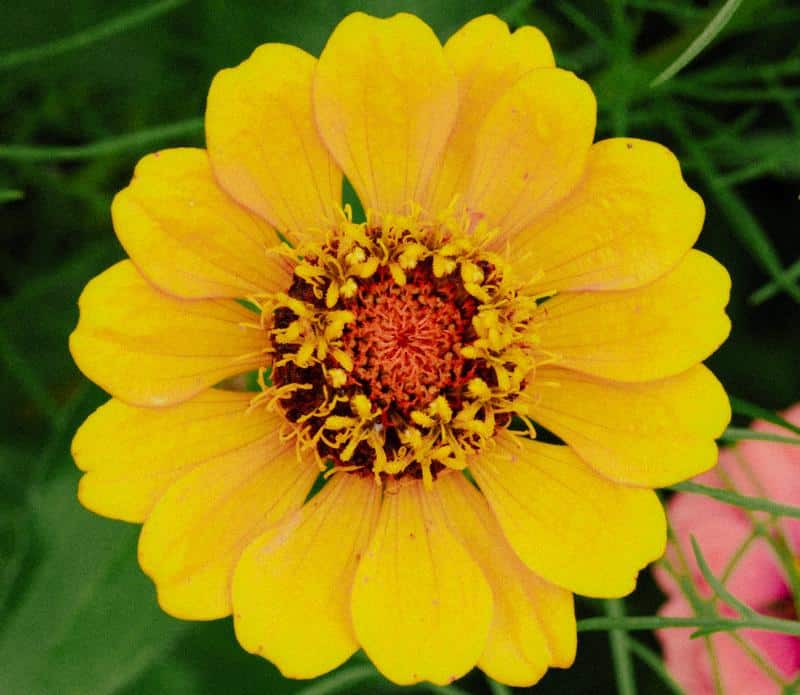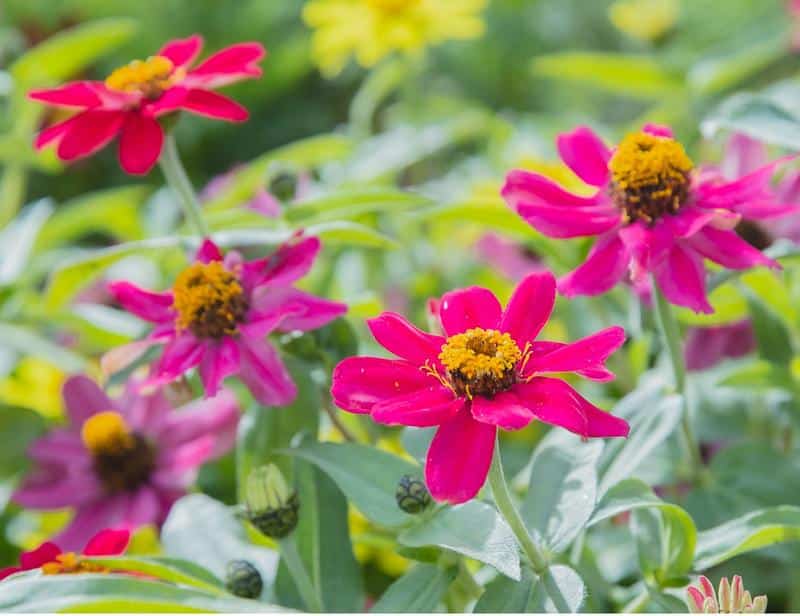Are Zinnias Toxic to Dogs? Are Zinnias Poisonous to Dogs?
Are zinnias toxic to dogs? Are zinnias poisonous to dogs? In this article, we’ll cover everything you should know about if zinnias are toxic to dogs, including what to do if they’ve already eaten some. We’ll then teach you the two commands that will ensure your dog is always safe around zinnias from now on.
Next, we’re going to go over the other important things you need to know about zinnias and dogs, such as how to keep dogs away from zinnias so they can grow bold and beautiful. Finally, we’ll finish all of this up by instructing you on how to plant, grow, and care for zinnias when you have dogs. Keep reading!
Are Zinnias Toxic to Dogs?

Zinnias are not toxic to dogs. These beautiful, vibrant flowers are safe for dogs to be around, and their ingestion typically does not cause harmful effects. However, it’s still important to discourage dogs from eating any type of plant to prevent potential gastrointestinal upset or blockages.
Are Zinnias Poisonous to Dogs?
Zinnias are not poisonous to dogs. They are considered non-toxic by the ASPCA and other pet health organizations. However, while zinnias are not toxic to dogs, any plant material can cause minor gastrointestinal upset if consumed in large quantities.
Symptoms may include mild vomiting or diarrhea, but these are usually self-limiting and resolve with minimal intervention.
Training “Leave It” Command
Despite zinnias being safe for dogs, training your pup on the “Leave It” command is still very helpful in stopping them from eating plants in general.
- Start by holding a treat in a closed fist.
- Say “leave it.”
- Wait until your dog stops trying to get the treat.
- Reward them with a different treat from your other hand.
Practice this command often, gradually increasing the difficulty, so your dog understands that “leave it” applies to all items you don’t want them to have. This command can be helpful in situations where your dog encounters potentially harmful plants.
Training “Drop It” Command
The “Drop It” command can also protect your dog from harmful items or substances they may pick up.
- Begin by playing a game of tug with a toy.
- Say “drop it” while stopping the play.
- When your dog releases the toy, reward them with a treat.
Practicing this command can ensure your dog will let go of something harmful they may pick up, such as a toxic plant or an indigestible object, thus keeping them safe.
While zinnias are not toxic to dogs, it’s still important to discourage your dog from eating any plants to prevent any possible stomach upset. Training commands like “Leave It” and “Drop It” can be incredibly useful in managing your dog’s behavior around plants and potentially harmful substances.
You need to know, however, that the underlying behavioral issues (curiosity, anxiety, boredom, etc.) that were causing all of this to begin with will continue to be present. And until you address those, any positive changes you see are only going to be temporary.
“Well, how do I make these changes last?”
By getting your dog to truly choose to follow your direction, that’s how. I tried many times to write out how you can do that before deciding it made more sense to just link you to the free video series that explains it better than I’d ever be able to.
The series is by a man named Dan who is one of the world’s leading dog obedience trainers. In it, he teaches you how to put an end to things like your dog eating zinnias and all other misbehavior using his fast and easy-to-follow methods.
In the first video, Dan will reveal to you why the two most common methods of dog training only doom you to failure. You can watch the video now by clicking here. Follow the proven system he’ll show you in his series and you’ll never have to spend another second worrying about your dog eating a zinnia ever again!
Can Dogs Eat Zinnias?

While zinnias are not toxic to dogs and generally safe if ingested in small quantities, it’s still best to prevent your dog from eating these or any other plants. Consuming non-food items can lead to gastrointestinal upset or potential blockages in your dog’s digestive system.
What to Do if Your Dog Eats Zinnias
If your dog eats zinnias, there are a few things to watch for but there is no need to panic as zinnias are not toxic to dogs. Look for signs of gastrointestinal upset, such as vomiting or diarrhea. If these symptoms occur and persist, consult with your vet. Always make sure that your dog has access to fresh water to help flush out any ingested plant material.
Can Dogs Eat Zinnia Leaves?
While zinnia leaves are not toxic to dogs, they should not be part of their diet. Dogs may not digest plant material effectively, leading to potential stomach upset or blockages. Therefore, it’s best to keep these and other non-food items out of your dog’s reach.
Dog Eating Zinnias: Is It a Cause for Concern?
In general, a dog eating zinnias should not be a cause for alarm as zinnias are not poisonous to dogs. However, regular consumption of any non-food items, including plants, is not recommended.
If your dog has a habit of eating zinnias or other plants, you may need to take preventative measures, such as installing a barrier around your flowerbeds or providing suitable chew toys to distract your pet. Teaching the “Leave it” and “Drop it” commands is also very helpful. You can learn both in the first section.
In conclusion, while zinnias are not toxic to dogs, it’s best to discourage your canine friend from eating them or any other non-food items. Monitor your dog for any signs of gastrointestinal upset if they have eaten zinnias and contact your vet if you have any concerns.
It’s a very good idea to handle this now because it will make sure that your dog keeps safe around plants in the future. You then won’t have to think about things like are petunias toxic to dogs, are Mexican petunias poisonous to dogs, are daffodils toxic to dogs, or are begonias toxic to dogs.
Zinnias and Dogs

Zinnias are not poisonous to dogs. However, it’s still a good idea to prevent your pet from consuming these or any other plants, as non-food items can potentially cause gastrointestinal upset or blockages.
How to Keep Dogs Away From Zinnias
One effective way to keep dogs away from your zinnias is to create a physical barrier, such as a fence, around your flowerbeds. Another strategy is to provide plenty of stimulating toys for your dog to play with, reducing the likelihood they will be interested in your plants.
Training is also essential – teach your dog commands like “leave it” and “drop it” to deter them from unwanted behaviors. Learn both in the first section.
Training Your Dog Not to Eat Plants
Training is a key part of preventing your dog from eating plants. The “leave it” command is especially useful. Start by showing your dog a treat, then closing your hand around it and saying “leave it.” Once your dog stops trying to get the treat and moves away, reward them with praise and a different treat.
Eventually, you can move this training to the garden and use it to discourage them from eating plants. This command will be much more effective when combined with the “drop it” command, which you can also learn in the first section.
Dog-Friendly Alternatives to Zinnias
If your dog seems particularly interested in your zinnias, it might be worth considering some dog-friendly alternatives. Herbs such as rosemary, thyme, and mint can be an excellent substitute, as they are non-toxic to dogs and can even contribute to fresh breath!
In conclusion, while zinnias pose no toxic threat to dogs, it’s always best to discourage your dog from eating any plants. Training your dog to understand commands like “leave it,” providing plenty of distractions, and considering dog-friendly plant alternatives can all help maintain both your dog’s health and the integrity of your garden.
How to Plant, Grow, and Care for Zinnias

Zinnias are an exceedingly straightforward plant to cultivate and care for, making them an excellent choice for beginner gardeners and experts alike. Their vibrant colors and ease of maintenance make them a popular addition to gardens.
The process of successfully growing zinnias involves directly sowing the seeds into your garden soil after the danger of the last frost has passed, positioning them in an area that benefits from full sunlight exposure, ensuring they receive regular watering, and applying fertilization if your soil is of poor quality.
To ensure that the zinnias continue to bloom throughout the season, you should also engage in regular deadheading of the plants.
Planting Zinnias
To plant zinnias in your garden, you should wait until the weather has warmed and all risk of a frost has passed. Choose a location within your garden that offers well-drained soil and is exposed to full sun for the majority of the day.
The zinnia seeds should be sown directly into the garden soil, with each seed being spaced approximately a foot apart from one another to prevent overcrowding as the plants grow. Once sown, the seeds should be covered with about a quarter inch of soil, followed by a generous application of water to settle the soil around the seeds and encourage germination.
Growing Zinnias
As the zinnias grow, it is crucial that they receive a minimum of six hours of direct sunlight each day. While zinnias are relatively drought-tolerant once established, for optimum growth and bloom production, they should be watered regularly.
It is best to water at soil level if possible, to prevent mildew or other diseases caused by moisture on the foliage. While zinnias are typically robust growers that often do not require additional fertilization, if your soil is particularly poor in nutrients, a light application of a balanced garden fertilizer can provide the zinnias with the necessary nutrients to thrive.
Caring for Zinnias
Proper care for your zinnias will ensure they continue to bloom throughout the season. This care includes regularly deadheading, or removing spent flowers. This practice encourages the plant to produce new blooms and extends the flowering season.
It’s also important to monitor your plants for any signs of pest infestations such as aphids or caterpillars. If you notice these pests on your plants, they should be treated as soon as possible with appropriate pest control methods.
The process of planting, growing, and caring for zinnias is relatively straightforward and rewarding. With the correct planting technique, adequate sunlight, regular watering, and simple maintenance, your zinnias will thrive and bring vibrant color to your garden.
Despite their non-toxic nature to dogs, it’s important to ensure your pets are trained to avoid disturbing these beautiful blooms in your garden. Learn to keep your dog away from them by going back to the first section. They can appreciate the blooms with you, from a respectful distance.
I’m sure you’re eager to get all of this taken care of so that your zinnias and dogs can thrive together, so I’ll let you get started now. Best wishes, and thanks for reading our article “Are Zinnias Toxic to Dogs? Are Zinnias Poisonous to Dogs?”





